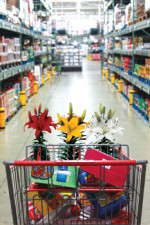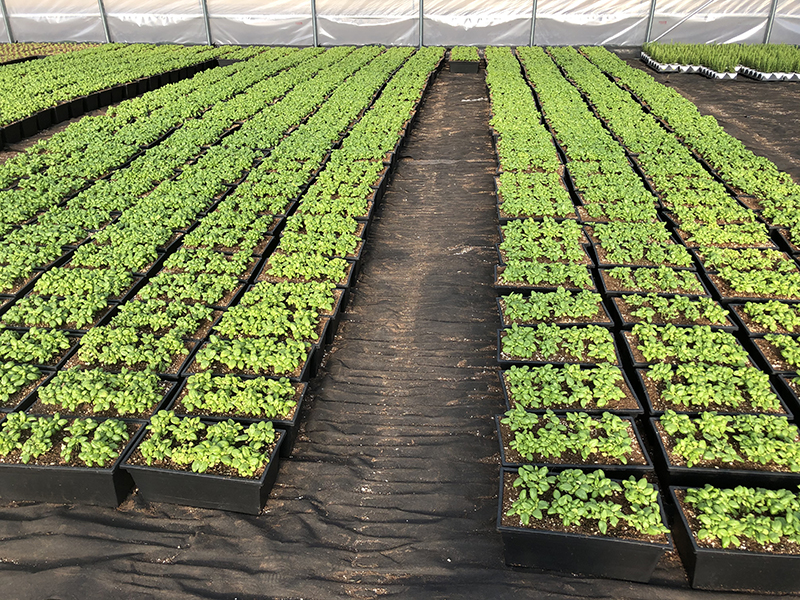The Curious Case Of The Wholesale Clubs

Walmart’s planogram, like those of the home improvement and supermarket chains, regularly incorporates live goods. The space those chains dedicate to live goods is roughly the same between stores, and the volume growers supply to each respective chain is enough to keep their greenhouses full and their operations in business.
Wholesale clubs are a different beast, though. Yes, BJ’s, Costco and Sam’s Club make up a massive retail channel, but live goods fit into their planograms differently. None of the three has a full-fledged garden center or floral department nationally. Instead, live goods are typically merchandised on wooden pallets and positioned wherever each club can make room for them in stores.
Sure, the live goods approach at the clubs is somewhat perplexing, and the supply challenges their growers face are daunting. But the rewards those growers reap, in many cases, trump the hoops they jump through in supplying the clubs.
“The clubs have figured out a way to bring in product on grower racks, get them in front of customers and sell them,” says Scott Giesbrecht, Green Circle Growers sales and marketing manager who works with Sam’s Club. “Their display is different and their execution is usually pretty good. In a limited SKU environment, their planogramming is typically strong. They’re very serious about space allocation. When space is given, the product will be there.”
The Challenges
Because the wholesale clubs employ a different strategy with live goods, the challenges their vendors face are also different than the challenges Walmart’s, Home Depot’s and Lowe’s vendors encounter. Many live goods are sold indoors, for starters, which forces growers to be very particular about the varieties they choose.
“We need to be a little more selective in picking out varieties that can tolerate the indoors, as well as colors that look right under the lights–especially during the spring season when we always have to be ready for a dip in the weather,” says Ed Van Hoven, the owner of American Color who serves Costco.
Per-store volume is a bigger issue. BJ’s, Costco and Sam’s Club don’t carry anywhere near the volume of a Walmart or a Home Depot, so each drop growers make is extremely limited. The goal of the clubs is to take in live goods and turn them as quickly as they can. So it isn’t unusual for growers to deliver small quantities to stores three or even four times per week. And because growers are making frequent deliveries to clubs, their transportation costs are pricey.
“It can be a challenge logistically because it’s all direct-store delivery,” says Marc Clark, the executive vice president at Rocket Farms who works with Costco. “It can be a challenge to get your truck to enough locations in a day before receiving closes. You just have to route your trucks properly. You have to get good at it.”
Still, as one club vendor who asked to remain anonymous for this story describes, his operation is serving 20 stores across six states. Compare that number to, say, between 20 and 50 Walmarts in a single state, and it’s easy to understand why growers gripe or shy away from the clubs.
“The guys who are making these types of accounts really work for them are the ones who have gone all in,” the vendor says. “They’ve invested a lot of time and energy and, in a lot of cases, personnel. They’re traveling frequently and assembling innovative ideas and containers. They’re offering things that keep their greenhouse in use and shipping workers busy in July, August and January. That’s how they’re really leveraging this.”
The Advantages
No grower-retailer partnership is immune from challenges, of course. If retail buyers ask for 50,000 petunias in white containers one day, change their mind a month later and decide they ultimately want those petunias in gray containers, the buyers are likely going to get what they want.
Surely every grower has a horror story or two about retail buyers gone mad, but growers can overlook those hiccups because each retailer offers its advantages, including the wholesale clubs. Although per-store volume isn’t as high at the clubs as it is at other retailers, growers seem to welcome the fewer SKUs focus.
“They’re not a complete garden center so they tend to focus on the top two to 10 SKUs in a category–maybe two to six SKUs at times,” says Dave Foltz, the new president at Ivy Acres who manages an account with BJ’s. “Instead of having everything A to Z, they move a lot of velocity of those two items. That’s a big plus just for efficiencies.”
Ten-inch poinsettias, 12-inch planters and hanging baskets are examples Foltz cites as items BJ’s moves with regularity. BJ’s may not move the total volume dollar of other retailers but sales are at least consistent.
“At Christmas time, poinsettias were flat or down at a lot of retailers but they were up tremendously at the clubs,” he says. “I think the customer sees they can get a very similar item for extreme value.”
Van Hoven says the fewer-SKUs approach works for Costco, as well.
“One of the advantages is that Costco does not run many SKUs, therefore the SKUs they do run are in large volume and very efficient in production and shipping,” he says. “They also run top-ticket items and the items that they run move through very quickly. The volume is definitely there on these items and the sell-through is quick.”
Another advantage of working with the clubs is their willingness to take on a grower’s surplus. BJ’s, for example, has purchased product from Ivy Acres that originally was grown for another customer. But if BJ’s sees value in that product, Foltz says they’ll take it and move it successfully.
“You used to see that a lot but you don’t anymore,” he says. “There are still opportunities other places but if you’re in a Home Depot, there’s one vendor in there. Another vendor can’t come in and put his product there.”
Other Benefits
Although a focus on fewer SKUs and a willingness to be flexible are attractive qualities to vendors, high foot traffic and the opportunity to grow year round are at the core of why growers do business with the clubs. Plus, because the clubs are focused on high quality and unique product, they’re more flexible on price than some other retailers.
“If you give them high quality and different, they become less concerned about price,” says one club grower. “The price is still important to them obviously–it’s probably their first consideration– but they don’t approach the business the way other boxes do.
“Other boxes think about footsteps so they can make more margin. The way the club approaches it is how do we present the right image to the customer? How do we communicate the right thing to our member? How do we make them feel? Then we’ll talk about how much money we’re going to make.”
Image isn’t everything to the clubs, though. They have, in fact, been trendsetters in some instances. Giesbrecht credits Sam’s Club as one of the earliest proponents of a 10-inch poinsettia program, and Clark says Costco clearly wants to differentiate itself with unusual items like the 10-inch plant you can’t find anywhere else for such a low price.
“They want to be innovative,” Clark says. “They would definitely not like to have the same old thing everyone else has. You want to say you’re glad you belong there because it’s a fantastic value, and that’s why you’ll see a plant retailing in there for $14 or $15 and the closest competitor may be $21. That’s a real value.”
Certain club stores are even improving how they display product, and that’s another incentive for growers to work with them.
“BJ’s is different than other retailers in terms of service,” Foltz says. “They take ownership of the product quite a bit. If we don’t get there, they’ll make sure a sign gets on it. The product may not be in the best possible spot, but they’ll make sure it’s on the floor and it’s sold.”
The clubs are also trying to create live goods opportunities for growers at times other than spring and the short fall mum and winter poinsettia stretches. Their approach to spring is somewhat different, too.
“As far as peak season, they want to make sure item performance for them is key,” Giesbrecht says. “In a low-margin environment, item performance becomes paramount. A lot of times you’ll see them getting in later–avoiding the risk of early-season shrink–and getting out early. You always want to go for that last dollar, but they really try to avoid late-season markdowns.”
Perhaps it’s because the clubs don’t pursue every last dollar that it’s refreshing for growers to work with them. Business at the club level certainly moves fast and every grower is faced with unusual challenges, but the rewards of supplying BJ’s, Costco and Sam’s Club are too good to pass up for most.
“Their ethics are very high and their word means a lot to them,” Clark says. “We work really hard to live up to Costco’s standards. It’s a partnership to us rather than an adversarial relationship.”
0
1
5
The Curious Case Of The Wholesale Clubs









